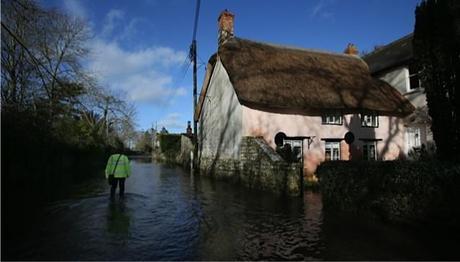
by Joanna M Foster / Think Progress
After yet another sodden weekend in much of southern England, 16 severe flood warnings, indicating the potential for loss of life, remain in effect — with hundreds of less dangerous warnings and alerts also still in place across the country.
Speaking ahead of the release of a government report on Britain’s unusually stormy winter weather, the Met Office’s chief scientist, Dame Julia Slingo said on Sunday that the U.K. had seen the “most exceptional period of rainfall in 248 years” and called the extreme weather “consistent with climate change.
“All the evidence suggests there is a link to climate change,” she said. “There is no evidence to counter the basic premise that a warmer world will lead to more intense daily and hourly rain events.”
The report, jointly produced by the U.K. Meteorological Office (Met Office) and the U.K. Center of Ecology and Hydrology, concluded that both Britain’s epically wet and windy winter and the unusually cold air over much of North America were linked to a persistent pattern of perturbations to the jet stream, over the Pacific Ocean and North America. The Pacific jet stream was deflected far to the north, bringing colder air south over Canada and the northern U.S. When this cold air entered the North Atlantic jet stream, the jet stream became stronger — about 30 percent stronger than is usual for December and January. The powerful jet stream set up conditions for active storm formation over the Atlantic and gave rise to a sequence of strong storms that battered the U.K.
The changes in the Pacific jet stream, which set all of this in motion, were driven by a heavy rainfall over Indonesia and the tropical West Pacific that has its roots in higher than normal ocean temperatures in the region.
The report also documented evidence for increased North Atlantic storm intensity and increased rainfall intensity in the U.K. While the number of strong winter cyclones in the North Atlantic has not increased since 1871, the report cited research showing an increase in their mean intensity.
The report said there was “emerging evidence” that daily heavy rain events in the U.K. may be more frequent. Downpours which fifty years ago occurred just 1 in 125 days are now more likely to occur 1 in 85 days.
Since December, the Environment Agency has issued more than 130 severe flood warnings. In all of 2012, there were just nine such warnings.
“We have records going back to 1766 and we have nothing like this,” Dame Julie said. “We have seen some exceptional weather. We can’t say it is unprecedented but it is exceptional.”
After his most recent tour of the destruction caused by the relentless rains in Somerset, Prime Minister David Cameron referred to the flooded devastation as “biblical.”
While experts warn that the insurance industry could be facing a bill of £500m from the winter flooding, farmers and environmental groups have been raising concerns about the consequences that the flooding will have on the nation’s food security.
The Department for Food, Environment and Rural Affairs (Defra) estimates that 35,000 hectares (86.4869 acres) of high-quality horticultural and arable land will be flooded at least once every three years by the 2020s. By the 2080s, that number could be around 130,000 hectares. About 58 percent of England’s most productive farmland lies within a floodplain.
“We need a response from government that recognises the importance for our long-term food security of safeguarding high-quality farmland,” Neil Sinden of the Campaign to Protect Rural England told the Guardian. “We need to view the countryside as more than a place for building, and value it for the food it provides.”
There are currently hundreds of flooded homes along the River Thames in the counties of Surrey and Berkshire to the west of London after the weekend storm and thousands more are at risk as the river continues to rise as the rainfall flows downstream. So far this winter, 8,000 homes have been flooded.
The Met Office is forecasting rain every day through February 14.

